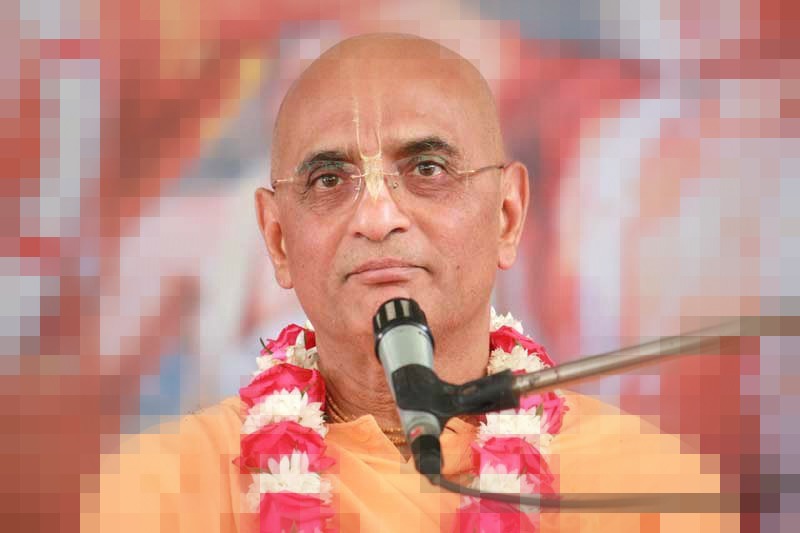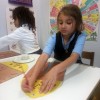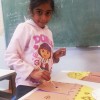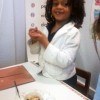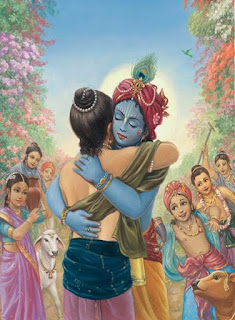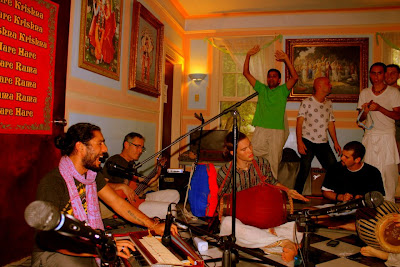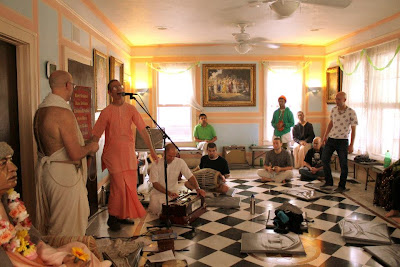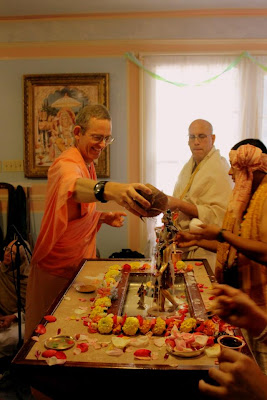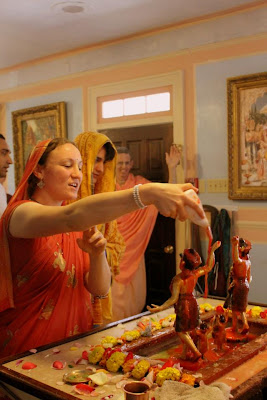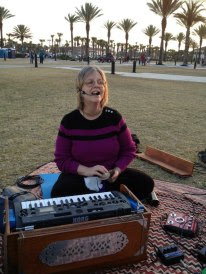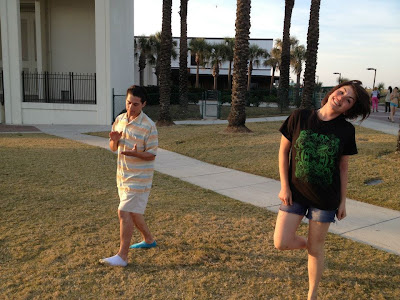Diary of a Traveling Sadhaka, Vol. 9, No. 6
By Krishna-kripa das
(March 2013, part two)
North Florida
(Sent from London, England, on May 7, 2013)
Where I Went and What I Did
I remained based at Krishna House in Gainesville for the second half of March, doing harinama on the campus and chanting at the Farmers Market on Wednesday as usual. During this time there were four special events that happened—a very successful day trip to University of South Florida in Tampa, a twelve-hour kirtana at Krishna House in Gainesville, a beautiful Gaura Purnima celebration, and a three-hour sunset kirtana at Jacksonville Beach.
I include insights from Srila Prabhupada books and different lectures. I also have notes on a recorded lecture by Radhanath Swami, and notes on lectures by both the senior and junior devotees who lecture in Gainesville and Alachua. Among the notes on classes, especially striking to me were the points made by Yogesvara Prabhu. I also have a few great spiritual rhymes from Kalakantha Prabhu’s A God Who Dances.
A Day Trip to University of South Florida
I went to Tampa one Wednesday to promote our Bhakti Yoga Society at the University of South Florida at their market day. I was not eager to go. Sometimes I feel it is hard for an old man like me to encourage college-aged people, so as I drove the two hours to Tampa prayed to Rupa Goswami, Bhaktivinoda Thakura, and Srila Prabhupada for their mercy. Srila Prabhupada prayed to Krishna for the ability to speak in a way suitable for his audience’s understanding, and I asked him to transfer the benediction he received to me. The market was canceled because of a prediction of rain. I chanted and talked to people for 4:45 hours anyway. One journalist who came to do a story on market day interviewed me because there was no one else. She had an interest in Buddhism, Hinduism, and traveling to India, and was very happy to interview me. As I was packing up I met another journalist who had wanted to do a story on Hare Krishna monks who visited his campus, but they left before he had a chance, so he was also very happy to interview me. He and one other girl I talked to came to our Wednesday evening program on the campus, and the girl took japabeads home to begin chanting on them. It is rare for me to get two interviews in one day and to also get two people to come to a program in one day. Krishna and His devotees are so kind to bless me with some little success. I can see there are some youth ripe for Krishna consciousness, even here in America.
Thanks to Ramiya Dasa Prabhu for pushing me past my limits once again by inviting me to come to Tampa, and thanks to Uma Devi Dasi for the books, blanket, flyers, prasadam,etc.
Twelve-hour Kirtana at Krishna House
One great addition made by Tulasirani dd to our Krishna House program is to have a twelve-hour kirtana each semester. We all had different services to make it happen, and Tulasirani won my heart by giving me the ecstatic service of dancing for eight hours in the kirtana! In addition, I made a carob coconut sweet, teaching one of the newer devotees, how to make it. [Actually I was not planning to make it carob, but as the milk burned slightly, I decided to add carob, so that would not be detected.] Many new devotees were encouraged to take part and sing for the Lord, at least for some time during the event.
For example, Kimani Daniels played the guitar and sang.
The talented Vishvambhara of the Mayapuris sang, getting a bunch of people to dance.
It was beautiful to see all the devotees take part in the chanting and dancing.
I had to dance as I led to try to make my quote of eight hours. I was very happy that a group of devotees danced to the end of my segment of the kirtana. It was also wonderful to see some devotees come who I had not seen at all in my three months stay in Gainesville. So the event really brought people together in service to Lord Caitanya, who inaugurated this dharma of the congregational chanting of the holy name, and we all felt enlivened to be part of it.
Because I promised I would go to another program, one by Dhira Govinda Prabhu, for those of his seminar attendees more interested in Krishna, I missed the last three hours of the twelve-hour kirtana, and was only able to dance for six hours, which I felt bad about. That Dhira Govinda program, however, had a special feature—three of us who chanted at the twelve-hour kirtana earlier also attended it, and there were three kirtanas at the program, with two being led by people who had never led the chanting there before. I do not know if there was a correlation between the presence of the kirtana singers who had sang earlier for several hours at Krishna House and the additional kirtana and enthusiasm to lead kirtana by the new devotees, but it was definitely very auspicious spiritually and a pleasure to witness.
I hope the twelve-hour kirtana becomes a regular part of our Krishna House program. Thanks to all who played a role in it.
Many thanks to Andrea, who took many beautiful pictures of the event, some of which you see here, and the rest which you can find on Facebook:
Gaura Purnima
The Krishna House Gaura Purnima abhiseka, or bathing ceremony, of Lord Caitanya and His spiritual brother, Lord Nityananda, was so ecstatic.
Generally I am not so much into abhisekas,but I must have poured water and other substances over the deities at least seven times, which was completely out of character for me.
It must be the influence of Lord Caitanya Himself and His enthusiastic devotees . I also danced while others bathed the deities.
Madhava and Baladeva Prabhus played key roles in organizing and executing the ceremony, and several Krishna House ladies decorated for it. Many thanks to Andrea, who took many beautiful pictures of the event, some of which you see here, and the rest which you can find on Facebook: https://www.facebook.com/media/set/?set=a.10151682144578296.1073741829.513518295&type=3
Gaura Purnima in Alachua was wonderful as usual, with the lively kirtana, the numerous devotees, and the great prasadam.
Sunset Kirtana at Jacksonville Beach
Amrita Keli Devi Dasi is always thinking of new events to share Krishna with people in Jacksonville. Thus she conceived of a sunset kirtana at the beach and invited devotee musicians
Purusharta Prabhu and Madhava Prabhu from the Alachua area
and Ekendra Prabhu
and his wife, Tulasi-priya Dasi,
from St. Augustine.
A carload of us came from Krishna House in Gainesville to participate. Four of Amrita’s friends from University of North Florida came and stayed for two and a half hours and the president of our Krishna Club there came for an hour or two with a friend. Two friends Amrita made while distributing cookies at the beach also came by.
I danced most of the time and some of the devotees joined me for some of the time.
Some of the students danced, including the girl Amee above, who said the event made her so happppppppy! A few new people came by.
I talked with some.
Some danced with us.
Many, many people took the numerous cookies and invitations we had. It was wonderful to see many people taking a step toward Krishna.
Amrita, Laura,
Lovelesh, and Mit
cooperated together to put on the nice event which they hope will become a monthly occurrence there in Jacksonville.
Thanks to Holt Knight, one of Amrita Keli’s college-aged friends, and Tulasi-priya Dasi for the photos.
Insights
Srila Prabhupada:
“I worship Lord Sri Caitanya Mahaprabhu, whose nectarean mercy flows like a great river, inundating the entire universe. Just as a river flows downstream, Lord Caitanya especially extends Himself to the fallen.” (Caitanya-caritamrita 16.1)
from a morning walk in September 1975 in Vrindavan, India, quoted in Back to Godhead, Vol. 46, No. 2, page 40:
“The Mayavadis say, ‘I am God.’ That is their foolishness. If they were equal to God, why does God say, ‘Surrender to Me’? They are not God. They are simply rascals who are claiming to be equal to God because they do not want to surrender to Him.”
from a morning walk in July 1975 in Denver, Colorado, quoted in Back to Godhead, Vol. 46, No. 3, page 44:
“A drop of ocean water contains the same ingredients as the big Pacific Ocean—it is qualitatively one with the ocean. But if a drop of ocean water says, “I desire to become
the ocean,” that is not possible. So, when we understand that we are qualitatively one and quantitatively minute in relation to the Supreme, that is our perfection.”
from a lecture on Srimad-Bhagavatam 7.9.18given onMayapur, West Bengal, India on February 25, 1976, quoted in Back to Godhead, Vol. 46, No. 3, page 8:
Mr. Max Mueller is very famous as a translator of the Vedas. Many scholars have read his translations, but none of them could understand the purpose of the Vedas because he’s not in the line of a sampradaya [spiritual lineage going back to Krishna].
“The self-effulgent Vaikuntha planets, by whose illumination alone all the illuminating planets within this material world give off reflected light, cannot be reached by those who are not merciful to other living entities. Only persons who constantly engage in welfare activities for otherliving entities can reach the Vaikuntha planets.”(Srimad-Bhagavatam 4.12.36)
“A devotee sees all living entities with spiritual vision and does not discriminate on the platform of the bodily concept of life. Such qualities develop only in the association of devotees. Without the association of devotees, one cannot advance in Krishna consciousness. Therefore, we have established the International Society for Krishna Consciousness. Factually, whoever lives in this society automatically develops Krishna consciousness.” (Srimad-Bhagavatam 4.12.37, purport)
In this age of Kali, if a person does not take advantage of chanting the Hare Krishnamantra, which is offered as a great concession to the fallen human beings of this age, it is to be understood that he is very much bewildered by the illusory energy of the Lord.(Srimad-Bhagavatam4.24.14)
Radhanath Swami:
from a recorded lecture:
When the Lord spoke to Madhavendra Puri in dream and ordered Him to extricate His Deity from the forest and install Him in a temple, he realized that it was the Lord who had brought him the milk when he was fasting. He simultaneously rejoiced and lamented.
A devotee is not interested in his own ecstasy nor is he very interested in repentance, he is simply interested in serving the Lord.
It is said that Krishna does not see what you give but what you hold back. That is why the residents of Vrindavan are so dear to Krishna. They hold back nothing.
Give the best of what you have to please Krishna, and you will undoubtedly get His supreme favor.
The villages surrounding the Gopal Deity celebrated the Annakuta festival for two entire years when He was installed in the temple.
Why should we invest all our energy in that which is guaranteed to be stripped away from us today or tomorrow?
When the devotees learn to love each other, that is the love of the spiritual world.
The devotee should hate the propensity to enjoy when he sees it in himself.
A devotee may be honored, but he sees all his attributes as belonging to Krishna and not his own. He tries to utilize the honor he is given to expand the service of the Lord.
Satsvarupa Dasa Goswami:
from CC Asraya:
Christian staying: “When we pray, we ourselves speak to God, but when we read, it is God who speaks to us.”
Kalakantha Prabhu:
Putana represents the false guru who gives sense enjoyment and liberation but not devotion to the Lord. As Putana was the first demon to attack Krishna, the false guru is the first obstacle on the path of bhakti.
Krishna is so attractive that ultimately other attractions will naturally fall away. We are pleasure-seeking and until we are attracted to Krishna, we will remain attracted things that are bad for us.
If we chant sixteen rounds and follow the four prohibitions against intoxication, illicit sex, gambling, and meat eating, that is like an inoculation against materialism.
Bhaktivinoda Thakura says this pastime of the brahmanas’ wives teaches attachment to Vedic literature is a obstacle on the path of bhakti.
What we do effects the hearts of others more so than our words. When the brahmanas saw the ecstasy of their wives who had offered food to Krishna, they realized their great mistake in neglecting to do so.
Humility and tolerance are not just to be demonstrated in the association of devotees, but more importantly outside that association.
Comment by Tulasirani devi dasi: I heard in a class by Radhanath Swami the gopis’ clothes symbolize the false ego, and Krishna therefore wanted to see the gopis in their original pure forms. Similarly Krishna wants to see us without false ego.
from A God Who Dances:
What pain is there for saintly souls devoted to the truth?
What evil is off limits for the low and the uncouth?
And what cannot be given up in service to the Lord
by those who want to please Him and desire nothing more?
You fill the desire of Your devotees
who conquer the ocean of death and disease.
They use the safe boat of Your soft lotus feet,
then leave it for others, their journey complete.
The soul immersed in ignorance cannot be satisfied.
When things go well he dances and when things go wrong, he cries.
He always sees some problems or immediate reward,
and never sees the all-controlling presence of the Lord.
Kaliyaphani Prabhu:
When the devotees perform a drama it is to be understood the Lord is appearing in the form of His pastimes.
Laksmimoni Devi:
The end of the Bhagavad-gītā is the beginning of Arjuna’s life as a surrendered soul, after his confusion is over.
We try to create a situation of freedom from anxiety. Anxiety is a useless emotion which disturbs us in the present and does not help us in the future. Therefore that Krishna promises to protect us from anxiety if we surrender to Him is no small thing.
We tend to value what someone believes, but what understands and how one acts on it is more important to Krishna as he indicates in the Gita. “O conqueror of wealth, have you heard this with an attentive mind? And are your ignorance and illusions now dispelled?” (Bg. 18.72)
We think that we have to enjoy everything. It is part of the American Nightmare.
Krishna has created this world as such an amazing prison that the prisoners voluntarily bind themselves up. In fact, they bind themselves up more and more each day with newly found ropes and shackles!
In the mode of goodness, we think we are happy. We are not hurting anyone, but we have no motivation to attain a transcendental state.
Sometimes there are too many voices in our head to hear the transcendental voice.
Following the order of the spiritual master, we find spiritual strength.
Q: Would shooting your TV be in the mode of passion?
A: No, because it is steals your time away from self-realization, and it gives you erroneous information. It is an aggressor, and it deserves to be shot.
Although cows are mistreated in the present civilization, their service is their offering of milk, and it is good for us to offer that milk to Krishna for their benefit.
Krishna consciousness is a lifestyle, and thus every act, word, and deed we perform in the course of the day affects our spiritual strength.
Sesa Prabhu:
As we have aspirations for our children, the Supreme Personality of Godhead, has aspirations for us.
Lord Caitanya said, “In every town and village My name will be chanted.” We often think of that as a prediction, but we can personally take it as His aspiration for us.
We can take the aspirations the Lord has for us, apply them in our life, and benefit ourselves and others.
Lord Caitanya also warns us, like a loving parent, about three faulty aspirations, those for wealth, those for fame, and those for women or men for sense enjoyment.
What to speak of solving the problems of life, mundane education creates additional problems.
Money is not as important as friends.
People adore fame but Gandhi was so harassed by people chanting “Gandhiji! Gandhiji!” he could not even sleep.
As far as the happiness in chasing men and women is concerned, just turn on any country radio station, and that illusion will be dispelled for you.
Famous thinkers advise serving others:
Martin Luther King, Jr.: Life’s most urgent question is: What you doing for others?
Henry Ford: To do more for the world than the world does for you—that is success.
Aristotle: The greatest virtues are those which are most useful to other persons.
Gandhi: The best way to find yourself is by losing yourself in the service of others.
Yet in the ultimate issue, considering ourselves the servant of the Supreme Lord, and not others, is the ultimate satisfaction.
The highest aspiration is to become a resident of Vrindavana dhama and serve Krishna eternally.
The purpose of aspirations is to take us beyond the ordinary.
Q: To maintain a family one requires money. How to we acquire it without losing our spiritual life?
A: It starts by cultivating a sense of being satisfied with what you have and what is easily attainable. Also consider Krishna has everything and is grateful, and so if you serve Him, will He not maintain you? In whatever situation we are in, we should use as much time as we can to cultivate our spiritual life.
Krishna says, “surrender and I will give mercy” while Lord Caitanya just gives mercy. Take your pick. What not take what Lord Caitanya has given and embrace it fully?
Yogesvara Prabhu:
The longer we stay in the material world, more we get covered by the dust of materialism.
The challenge is how to present the eternal philosophy of bhakti in language of 2013.
One way of stating Bhagavad-gita philosophy is “there is more to you than the cumulative bruised psyche of this one life.”
Human beings seem to benefit from stressful situations. Perhaps that is one reason not very much innovative work has come out of Hawaii.
I see Bhagavad-gita is parallel to advanced psychology.
Do you know how many people have committed suicide after having won the lottery?
According to ABC TV, in America half the people believe in reincarnation and half do not.
I explain the basics of Krishna consciousness and then we start with a round of japa and kirtana, and end in arati.
The biggest difficulty people have with Krishna is that He is a person. Why is that:
Persons they have met are defective.
They do not want to be answerable to a person.
They think Krishna is a foreign God.
They do not like the idea that anyone is greater than them.
One problem is that in this life, every relationship has been frought with pain.
If you are afraid to go beyond looking at just the surface, then you will never get past your resentment.
The pain may be inevitable, but the suffering is optional.
Spiritually we are whole and unblemished, but to realize that, we have to perform some practice.
I was very bold and asked Srila Prabhupada many questions. Once I asked him, “What is it like being a pure devotee? For example, how do you see a tree?” Srila Prabhupada replied that you do not just see a tree, you see the soul of the tree is part of Krishna, and therefore you are seeing Krishna.
from a seminar on Sri Isopanisad given in Gainesville, March 18–19, 2013:
The invocation of Sri Isopanisad appears in other works. It is a maha-vakya, a resounding statement of purpose: “The Personality of Godhead is perfect and complete, and because He is completely perfect, all emanations from Him, such as this phenomenal world, are perfectly equipped as complete wholes. Whatever is produced of the Complete Whole is also complete in itself. Because He is the Complete Whole, even though so many complete units emanate from Him, He remains the complete balance.” (Sri Isopanisad, Invocation)
We have a suspicion that we will not be taken care of, and therefore we conclude that we have to look out for number one [meaning ourselves].
“Killing the soul” means “not to nourish the soul.”
If you see someone has harmed you, without the higher knowledge of the Vedas, you are left with your own resentment and desire for revenge.
If you can find bliss on the battlefield as Arjuna did, then can you not find bliss in doing your own duties in life for Krishna.
Worse than making a mistake is to make an excuse for doing it again.
When we would travel with Srila Prabhupada, he was so curious about the world around him! And he used the knowledge he obtained in his classes and his writing.
I know a lot of people who worshiped the demigods of Wall Street and got hit hard in 2008.
Sri Isopanisad, like Bhagavad-gita, starts externally, and develops into a very internal prayer.
Our very small independence is to choose what to depend on.
If we develop the desire to live without Krishna, there has to be a place for us to go. That is the material world.
I asked Srila Prabhupada, “If everything is so good in the spiritual world, what did we come here?” He gave an example. Suppose you are a rich man, and you have your chef, and you have the same great, rich food every day. You could develop the desire to just have some simple chipped rice for a change. Similarly, we can develop the desire to do something besides serve Krishna for a change.
It is glorious that we have the option to come to the material world, because once we realize how bad a decision it, we can completely give ourselves to Krishna.
We were just at Home Depot. Everyone is building their own mansions.
There are some correlations between Vedic and modern astrophysics:
4.320 days: Jupiter’s orbit according to Vedic astrophysics
4,332 days: Jupiter’s orbit according modern astrophysics
10,800 days: Saturn’s orbit according to Vedic astrophysics
10,800.5 days: Saturn’s orbit according modern astrophysics
There is reflective and popular spiritual life. Reflective spiritual life is for the intellectuals while popular spiritual life is more sentimental.
“The most beautiful and profound emotion we can experience is the sensation of the mystical. It is the source of all true science. He to whom this emotion is a stranger, who can no longer wonder and stand rapt in awe, is as good as dead. To know that what is impenetrable to us really exists, manifesting itself as the highest wisdom and the most radiant beauty, which our dull faculties can comprehend only in their primitive forms— this knowledge, this feeling, is at the center of true religion.” (Albert Einstein)
“My religion consists of a humble admiration of the illimitable superior spirit who reveals himself in the slight details we are able to perceive with our frail and feeble minds. That deeply emotional conviction of the presence of a superior reasoning power, which is revealed in the incomprehensible universe, forms my idea of God.”(Albert Einstein)
Newtonian physics does not work well for small things like atomic particles or large things like universes.
Himavati dd told me that during Srila Prabhupada’s visit to Hamburg, she saw him sitting in the light of the setting sun with his eyes closed for several minutes. When he opened his eyes he chuckled, and said he was experimenting with traveling to the sun via its rays. Actually it is said that the yogis can travel by the rays of the setting sun.
Prabhupada himself would have his disciples read the newspaper to him. It is important to know what is going on to be relevant to our audience.
Srila Prabhupada was upset when scientists claimed that there was no God, but he did not deprecate their dedicated and enthusiastic study of the Lord’s amazing creation.
The experiences of this life are the tools for your own self-awareness.
You have to find a balance.
Particle physics has brought us the electronics that our laptops, iPods, and cell phones use today.
The same evidence analyzed by different people is interpreted in different ways.
If you eliminated all the space within and between the atoms of the Empire State Building, you would have something the size of a pea of tremendous weight.
At the subatomic level, everything becomes unpredictable. All bets are off.
The universe has curled up dimensions that are too small to measure.
At the lowest level, human will can affect the behavior of subatomic particles.
The electron was seen to behave like a particle when observed but otherwise like a wave.
Particles appear to be be able to go in a variety of ways until observed, in which case they only go in one way.
There is no scope for the Supreme to act in our lives until we provide the opportunity.
There is a difference between the sentiment to be spiritually advanced and the practical steps to attain that goal.
There is a phenomenon where two companion particles which have the properties of upward and downward spin are separated by a one hundred miles and when the spin of one is changed, the spin of the other also spontaneously changes.
Studies show at absolute zero, particles lose their distinguishing features. This reminds us of the Vedic idea of matter having a primal undifferentiated state.
One lady had a mystic experience a vision of Prabhupada, saw his picture on the books, and found him out. She explained her story and told Prabhupada she thought it meant he was her teacher. Srila Prabhupada accepted that but encouraged her in the basics and advised her not to depend on mystical experiences.
Although you may have some occasional higher experience, if you stick with the basics of Krishna consciousness, you will never go wrong.
The conservative and liberal sides both have value. The conservatives keep what has worked intact while the liberals facilitate needed innovations. Those espousing each need to learn how to get along with the other.
Pran Govinda Prabhu:
To understand Lord Caitanya we must appreciate His merciful nature, and come to love Him, and this way we can attain Radha-Krishna.
One devotee was telling Srila Prabhupada that he had no attraction to Krishna. Prabhupada asked if he was attracted to anything, and he listed his favorite objects of attraction, and Srila Prabhupada advised the devotee trace back that attraction to Krishna, the original source.
In the spiritual world everyone is satisfied in their service to the divine couple, Radha-Krishna, and thus they deal with each other very nicely. That is what Lord Caitanya came to give.
We don’t chant the holy name, we serve the holy name.
Without chanting under the guidance of the guru, we do not get the result.
The Lord is the ultimate of end of all the senses.
Radha Krishna have a tremendous ever fresh mutual attraction.
According to Padma Purana, the Lord was wandering if anyone could empathize with Him. At that point, a supremely attractive female appeared from His left side with the zeal to serve Him that struck Him with amazement. That was Radharani.
Lord Caitanya is giving unlimitedly, but we get as much as our faith allows.
Lord Caitanya is relishing great spiritual happiness, and when you connect with him through guru, scripture, and saints, according to your eligibility you can relish that happiness.
There is one pastime when Srila Prabhupada cried in spiritual ecstasy and the other people in the temple also began to cry. His disciple said he left the room because everyone was crying, and Srila Prabhupada said “This movement is simply meant for crying for Krishna.”
We do not know if Radha-Shyamasundara will accept our offering, but if we work under Srila Prabhupada he will be bound to accept.
One buttermilk salesman offered Lord Caitanya some buttermilk, but Lord Caitanya drank the whole batch he was to sell that day. The buttermilk salesman was in great anxiety, but when returned home, he found his buttermilk container was filled jewels with enough value to maintain his family for ten generations.
Rohini Kumara Prabhu:
If you learn how to do one thing, let it be to associate devotees.
Akuti Devi asked a Godsister, “How are you and the holy name?”
comment by Tulasirani dd: Association with devotees is more important than chanting the holy name because the devotees inspire us to chant.
Being a leader you have one foot in heaven because of your devotional engagement and one in hell because you have to criticize devotees to help them improve, and thus you can become proud or even offend a devotee.
comment by Vaishnavi Devi: Sacinandana Swami explained that to full our cup with liquid one must place the cup below the vessel we are pouring from. Similarly we must position ourselves below the person who is giving mercy to receive it, therefore we must be humble.
comment by Marlon: There is a part in the Bible that says the mercy far exceeds judgment. By judging you become proud, but if you exist on mercy there is no pride.
comment by Tulasirani dd: After 9:00 p.m. your service should be taking rest, so you can do some service tomorrow.
Krishna consciousness is the best thing that is ever going to happen to you.
We have to be enthusiastic to be successful in devotional service.
We must avoid the mentality, “I only serve my guru. My guru is everything. Everyone else is a shmuck.” You may laugh, but I actually heard someone say that.
Sometimes we see that materialists seem not to be struggling, but that is just because they are going with the flow of the material energy.
Tulasirani dd: I used to smoke pot all day every day, but found that it brought me down from the high from chanting Hare Krishna, so I would do it less and less. Finally I did not take either alcohol or pot for a whole month which was amazing for me, even a day would have been amazing. My pothead friends said I should celebrate by getting high. So I got completely stoned. I remember thinking that I just want to sit down, then I want to eat, and then I wanted to pass out. And I observed how selfish how was. If potheads sit around and discuss changing the world, they cannot do anything to help everyone, because they do not have the ambition.
Guruttama Prabhu:
Once Lokanath Swami asked a question during a New Vraja Mandala Parikrama, “Why do so many demons disturb Krishna’s pastimes?” The answer was that Krishna gets so absorbed in his play that he forgets to eat lunch. The killing of the demons creates a break in the play, and afterward he remembers to eat lunch.
The prayers of the demigods are valuable because they are sharing their realizations which we can learn from. Srimad-Bhagavatam, which is full of such prayers, is very practical.
comment by Kalakantha Prabhu:
All the gopis wanted to marry Krishna and so to accommodate their desire He arranged that they were betrothed to the copies of His friends who were expansions of His very self during the year Lord Brahma hid His friends.
Caitanya Carana Prabhu:
quoted in Back to Godhead, Vol. 46, No. 3, page 14:
“Even if we don’t feel fully happy in Krishna consciousness, the only way to greater happiness is not outward, but inward—not out of Krishna consciousness, but deeper into Krishna consciousness.”
Dina Bandhu Prabhu:
Studies show the orphans that were not physically touched by a person died of deficiencies in calorie intake and protein although being given sufficient food. Thus the touch of a person is very important. Similarly in our spiritual life, touch of the personality of God is very important to spiritual survival.
comment by Darlina:
My mother taught me God was like the sun and was so bright you could not see Him. I did not like the sun, it was always too bright to look at. I preferred to look at the moon. Because of being brought up in that way it was hard for me to develop a relationship with God. Reading about Krishna has helped me.
comment by Laura:
Krishna can transform his material energy to his spiritual energy or his spiritual energy to his material energy. So the deity is an example of that.
comment by Amrita Keli dd:
For the first six months I did not notice the deities were in the temple. After a while I realized if I have a form, why shouldn’t God have a form. It is prideful of me to think of having something God does not have.
comment by Mit:
I noticed the deities but thought of them more as attractive statues. One day I was staying with a devotee, and I was so tired when my alarm clock went off, I told my friend, “I am too tired. I am not going to the mangala arati [morning service]. Tell Them I said, ‘Hi!’” I think that was the first time I even thought of the deity as a person.
My friend replied, “They want to see you.”
I said, “Why did you say that!” knowing I would have to get up. I got up although I was more tired than I had ever been. That day during the morning service, the deity was not blocked from my vision by others, as He is sometimes in the temple.
Namamrta Prabhu:
When the boys want Krishna to enjoy the fruits in Talavan forest, they tell Krishna that they want the fruits for their enjoyment because they know His desire to please His friends is stronger than His desire to please Himself.
comment by Caitanya dd: I was a care giver for 17 years and witnessed 11 people die. Those who were somewhat God consciousness were peaceful at the end, but the others were in great anxiety.
Hanan:
Lord Caitanya taught the chanting of Hare Krishna in which the process and the goal are the same.
When Srila Prabhupada was asked the goal of chanting Hare Krishna, he replied, “More chanting.”
In the time of Lord Caitanya, Kazi’s soldiers would stop the chanting the holy name in one part of city of Navadvipa, and then they would hear it in another place, and it would continue to go on like that, and thus the Kazi and his soldiers were frustrated.
When Lord Caitanya organized a huge congregational chanting party to protest the attempts the Kazi to stop them, although it was night there were millions of people carrying so many torches it appeared like daytime. The Kazi sent soldiers to stop the chanters but influence of the chanting party was so great most of them ended up joining it. When the Kazi heard that, he sent more people to break up the chanting party, but they all ended up joining it. The thieves noticed people ran to join the chanting, leaving their doors open, and thought it was a great opportunity to plunder them, but the chanting was so powerful, they ended up joining the kirtana instead.
There are many branches on the Lord Caitanya tree, and Srila Prabhupada explained that our ISKCON is on the branch from Sanatana and Rupa Goswamis.
A king was frustrated because his servant, who had nothing, was happy while the king himself was not. He asked his minister who said he would tell him if the king gave him 99 gold coins. The minister took the bag of coins and hung it on the servant’s door. The servant looked in the bag. He was distressed that there were only 99 coins and decided to work two jobs to purchase one more so he would have 100, and by doing this his happiness was lost.
The mind is only looking for a new situation of enjoyment. If we are married, we wish we were single. If we are single, we are looking for a wife or husband. Now people are celebrating their divorces. Formerly they would just celebrate their marriages.
In India I saw people living in the street, bathing in the street, dressing in the street, and yet they were happier than people with much more opulence. I stayed some time to learn why.
Often I have asked, “What do you do if you have material desires?” The best answer I heard was from a recorded lecture by Kadamba Kanana Swami: “You put them on a shelf, and pray to Lord Balarama to take care of them. Then in a year or two you look at the shelf, and realize that they are not there. Lord Balarama took care of them.”
Bhaktin Amanda:
It was striking to me that Krishna does not think about His personal needs for the seven days he was holding up Govardhana Hill.
I heard a lecture by Radhanath Swami on the Govardhan pastime. He describes the Indra yajna that Vrindavan residents performed was officially done without much feeling, but when enlightened by Krishna to understand the value of Govardhan Puja, they eagerlyperformed it with devotion.
Radhanath Swami also explained that Indra made the mistake of thinking that his service of providing rain belonged to him instead of being given to him by Krishna and thus belonging to Him.
Despite the darkness created by the clouds of Indra, the place was lighted up by the effulgence of Krishna’s toe nails.
While Krishna was holding the hill with one hand, he played on this flute with the other to please His friends.
comment by Rupacandra Prabhu: This pastime is arranged so all the residents of Vrndavana could simultaneously be with Krishna for seven days straight.
comment by Syamala Kishori dd: The demigods like Brahma and Indra easily give up their pride and accept Krishna while the demons resist.
comment by Dvarakadhisa Prabhu: Our juice in life is trying to understand Krishna.
comment by Marlan: It seems to me that Krishna does not like to play the role of God.
comment by me: He does not like to be limited to playing the role of God. He plays God in Vaikuntha, and plays as a devotee as Lord Caitanya, and enjoys playing in many other ways, and all these forms are simultaneously manifest because His desire to enjoy in these ways is eternal.
Bhaktin Valentina:
Goodness conditions us to a sense of happiness and knowledge, but it is not real happiness nor real knowledge.
The descriptions of the modes of material nature are like a road map we can use to see if we are moving in a positive direction.
“When one dies in the mode of passion, he takes birth among those engaged in fruitive activities; and when one dies in the mode of ignorance, he takes birth in the animal kingdom.” (Bg. 14.15) This verse shook sort of me up. There is an urgency in this human form of life. Am I ready to leave when the bomb explodes?
comment by Bhaktin Lacie: Being in the material world, is like being in a house with three rooms, goodness, passion, and ignorance—you can change rooms but you cannot leave the house.
Franco:
from an ice-breaker at the beginning of a class:
For spring break, I visited one of my best friends in Tallahassee, and I noticed she was in the same state she has been for the last three years, simply absorbed in her studies and her partying. Meanwhile I have been coming to Krishna House for the last year, and I feel that I have really grown in a lot of ways. It was striking to see such a good friend in the same place as before with no desire to get beyond it.
-----
bhavanti bhuvi ye narāḥ kalita-duṣkulotpattayas
tvam uddharasi tān api pracura-cāru-kāruṇyataḥ
iti pramuditāntaraḥ śaraṇam āśritas tvām ahaṁ
śacī-suta mayi prabho kuru mukunda mande kṛpām
“Even low-born, sinful souls entrapped in Kali’s Age,
Suffering uncounted pains that no one can assuage,
Are instantly delivered when You kindly seek them out
And flood them with Your splendid mercy, making bhaktisprout.
And so with heart rejoicing at Your mercy’s endless store,
I take full shelter of Your lotus feet and then implore,
O Lord Caitanya! Sri Mukunda! Saci’s precious jewel,
Please shower Your compassion on this wretched, stubborn fool.”
(“Tritiya Caitanyastaka,” Verse 5, from Stavamala,by Rupa Gosvami, English poetization by Dravida Dasa)

